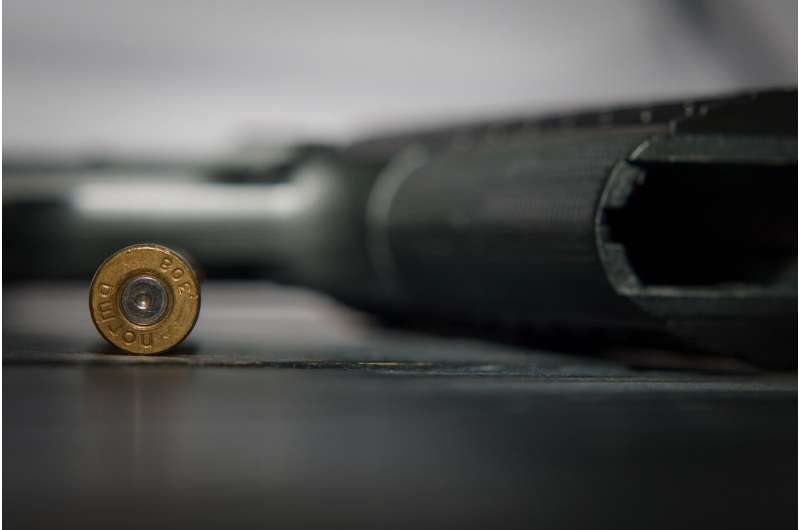
Handguns may not just increase the risk of suicide for people who own them.
A new study concludes women face a greater risk of suicide when they have “secondhand exposure” to guns owned by other people, too.
A recent study published in JAMA Psychiatry builds on previous research that has linked access to firearms with increased suicide risk. But in this study, researchers focused on women who live with other people who are handgun owners.
Investigators concluded those women are nearly 50% more likely to die by suicide than those who live in gun-free homes.
“The question that we wanted to get the answer to was how does a woman’s suicide risk change when someone that she’s living with in a gun-free home becomes a new handgun owner?” said Dr. Matthew Miller, the lead author of the study and a professor at Northeastern University.
Researchers examined multiple databases to track, from 2004 to 2016, the experiences of 9.5 million adult women in California who weren’t gun owners. All the women lived with at least one other adult in a gun-free home at the start of the study. But more than 330,000 of the women started living with gun owners over the course of 12 years, after someone in the home legally acquired a handgun.
During the study period, 2,197 women died by suicide and about 15% of those deaths were by firearm.
The study found the overall suicide rate rose by more than 40% among women who were exposed to household handguns compared to those who remained in gun-free homes. The increase was attributed entirely to deaths by firearms, as women in households with and without firearms had similar rates of suicide by non-firearm methods.
“The excess rate of firearm suicide among cohabitants of handgun owners,” the researchers wrote, “was apparent shortly after the first handgun was purchased and persisted as long as the household contained at least 1 handgun.”
Co-author David Studdert, a professor at Stanford University, noted one possible explanation.
“When a gun comes into the home, suddenly, there’s a lethal means at everyone’s disposal, potentially, and firearms are an extremely lethal means,” Studdert said. “There are not many second chances after a suicide attack with a firearm.”
Suicides have long accounted for the majority of gun-related deaths in the nation. A little over half of all suicides in the U.S. in 2020 involved a firearm, according to the Centers for Disease Control and Prevention.
“I’m hoping that by quantifying this imposed risk,” Miller said, “people will bear that in mind when making a decision about whether to to bring guns into into into a gun-free home.”
Researchers noted that because of the nature of the databases in the study, it was not possible to measure for some other complicating factors.
A previous study by the researchers found that women who own handguns were seven times more likely to die by suicide than women who don’t own handguns.
Coping skills, support from loved ones, and mental health treatment work to protect most people who have suicidal thoughts from a successful attack. Often, people attempt suicide within an hour of the thoughts of killing themselves start, and one survey found people gave the decision less than five minutes of thought. That timing is one reason some experts say makes delaying access to lethal means critically important to saving lives.
Firearms and suicide prevention
The presence of firearms in the home is among the main risk factors for suicide, according to the National Institute of Mental Health.
“Anytime we have firearms accessible to someone at risk of suicide, we see greater numbers of deaths,” said Dr. Dan Reidenberg, executive director of Suicide Awareness Voices of Education. “It’s really about ease of access, ease of use and likelihood of death.”
Having a gun in the home, Reidenberg said, increases the risk suicide “no different than, if there’s a firearm around, there’s going to be a risk of death, not just death by suicide, or serious injury.”
Because guns are a highly lethal means of suicide, “this method doesn’t allow time for the person to be interrupted, make a different decision, access help or survive an attempt,” said Doreen Marshall, vice president of mission engagement at the American Foundation for Suicide Prevention, in an email.
Limiting access to firearms, by removing them from the home or storing them securely and unloaded, reduces the risk of suicide, Reidenberg said.
“Anytime you place a barrier between somebody who’s thinking about death or looking for a way to die and you make it more difficult for them to access a method, then they’re less likely to die because the suicide ideation will pass,” Reidenberg said.
Research shows, Marshall said, when people in a crisis don’t have as easy access to a lethal suicide method, they are more likely to survive.
“Firearm owners should always store their firearms locked and unloaded, separate from ammunition and in a locked safe,” Marshall said. “In addition to removing or storing firearms safely, we strongly recommend and support suicide prevention education for owners of firearms.”
Preventing suicides by firearms, Reidenberg said, isn’t just up to the gun owner in the home.
“This is a bigger issue than just the firearm owner who purchased a gun, who has it in house, who doesn’t think that somebody would ever use it,” Reidenberg said. “It’s really all of us that are around somebody who’s at risk of suicide, and in particular by firearm, that needs to make sure that they’re doing the right thing.”
Amanda Pérez Pintado, Usa Today

